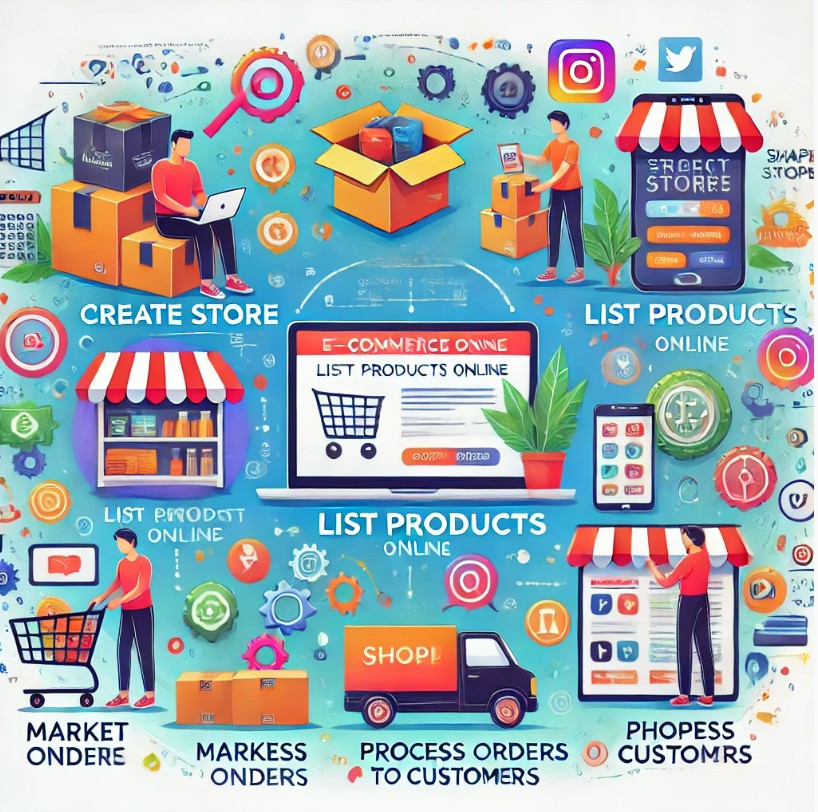In today’s digital economy, knowing how to sell product online isn’t just a valuable skill—it’s often a necessary one. Whether you’re an entrepreneur starting a new venture, an artist selling handmade crafts, or a business owner pivoting to e-commerce, selling online provides incredible opportunities to reach a global audience, reduce overhead, and increase profit margins.
This in-depth guide will walk you through everything you need to know—from product selection to customer retention—so you can start or scale your online business with confidence.
Why Sell Products Online?
Selling products online is more accessible than ever before. Here are a few reasons why entrepreneurs are flocking to e-commerce:
- Low Startup Costs: You don’t need a physical storefront, which reduces overhead costs.
- Global Reach: Reach millions of potential customers worldwide.
- 24/7 Availability: Your store can make sales even while you sleep.
- Data-Driven Decisions: Online platforms provide analytics to help you understand buyer behavior and improve performance.
- Scalability: Scale your business faster than a traditional retail store.
According to Statista, global e-commerce sales are projected to hit $7.4 trillion by 2025, making it an industry ripe with opportunity.
Step-by-Step Guide to Selling Products Online
Step 1: Choose the Right Product
Start with a product people want. Successful online sellers often focus on one of these:
- Niche products: Items with a specific, dedicated audience.
- Everyday essentials: Products that fulfill daily needs.
- Trending items: Use tools like Google Trends, TikTok, or Amazon’s Movers & Shakers to spot them.
- Handmade or custom goods: High profit margins and less competition.
Tip: Validate demand before sourcing inventory. Use surveys, social media polls, or even pre-orders to test interest.
Step 2: Identify Your Target Audience
Understanding who you’re selling to is critical.
Ask:
- What age range is my customer?
- Where do they live?
- What are their interests and pain points?
- What motivates them to buy?
Create buyer personas to shape your marketing, design, and messaging.
Step 3: Select an Online Selling Platform
Choose the platform that aligns with your goals and audience. Options include:
- Shopify: Best for building your own branded store.
- Amazon: Massive customer base, but high competition and fees.
- Etsy: Ideal for handmade and vintage products.
- eBay: Great for collectibles and secondhand goods.
- WooCommerce (WordPress plugin): Best for custom stores.
- Social media shops: Instagram, Facebook, and TikTok Shops are rapidly growing.
Step 4: Set Up Your Online Store
Once you’ve chosen your platform:
- Choose a domain name: Make it simple, memorable, and related to your brand.
- Design your store: Use professional themes that are mobile-optimized.
- Add essential pages: About Us, Contact, Shipping & Returns, FAQ, Privacy Policy, Terms of Service.
Step 5: Create Compelling Product Listings
This is where many sellers go wrong. Great product listings = more conversions.
Best practices:
- High-quality images (multiple angles, zoomable)
- Descriptive product titles with keywords
- Bullet-point features and benefits
- SEO-optimized product descriptions: Include target keywords naturally.
- Customer reviews: Encourage reviews and testimonials.
Step 6: Set Up Payment & Shipping
Make buying easy and secure.
- Payment gateways: Stripe, PayPal, Square, or platform-native options.
- Shipping solutions: Offer multiple options—standard, expedited, international. Use tools like ShipStation or Easyship for fulfillment.
Pro tip: Offer free shipping (even if the cost is built into the price). It reduces cart abandonment by up to 50%.
Step 7: Promote Your Products Online
Use a combination of organic and paid marketing:
a. SEO (Search Engine Optimization)
- Optimize your product pages, images, and blog posts.
- Use keyword tools like SEMrush, Ubersuggest, or Ahrefs to find buyer-intent phrases like “buy eco-friendly phone case online”.
b. Content Marketing
- Create a blog with tips, tutorials, and product stories.
- Include CTAs (calls to action) directing readers to your shop.
c. Email Marketing
- Build an email list with pop-ups or lead magnets.
- Send newsletters, product updates, and promotions.
d. Social Media Marketing
- Use Instagram, Pinterest, TikTok, and Facebook to showcase products.
- Use influencers and user-generated content (UGC).
e. Paid Ads
- Facebook & Instagram Ads for retargeting and awareness.
- Google Shopping for direct product searches.
- TikTok Ads for younger demographics.
Step 8: Manage Orders and Customer Service
Stay organized:
- Use order management tools to track inventory, payments, and delivery.
- Provide excellent customer service—quick responses, clear communication, and generous return policies lead to better reviews.
Top Online Selling Platforms (Comparison Table)
| Platform | Best For | Fees | Customization | Traffic Source |
|---|---|---|---|---|
| Shopify | Branded online stores | Monthly + transaction | High | Drive your own traffic |
| Amazon | High-volume sales | Referral + fulfillment | Low | Amazon’s audience |
| Etsy | Handmade/vintage | Listing + transaction | Medium | Etsy search |
| eBay | Auctions & used goods | Listing + final value | Low | eBay search |
| WooCommerce | Custom WordPress sites | Hosting + plugins | High | SEO & social |
Tips for Increasing Online Sales
- Offer time-limited discounts or flash sales.
- Use scarcity and urgency (e.g., “Only 3 left in stock!”).
- Upsell and cross-sell: Recommend related products.
- Add live chat support: Increases conversion rates significantly.
- Use retargeting ads to bring back visitors who didn’t buy.
- Optimize for mobile: Over 60% of e-commerce sales happen on smartphones.
Common Mistakes to Avoid
- Poor product photography: This kills trust instantly.
- Too many or too few product options: Confuse or bore customers.
- Slow-loading website: Affects SEO and frustrates users.
- Not testing your checkout process: Always test from the customer’s perspective.
- Ignoring analytics: Data helps you scale faster and smarter.
Future Trends in Online Selling (2025 and Beyond)
Stay ahead by embracing these trends:
- AI & personalization: Chatbots, product recommendations, personalized emails.
- Voice search optimization: Think “Hey Alexa, order running shoes.”
- Social commerce: Selling directly via Instagram, TikTok, and YouTube.
- Sustainable products: More buyers are eco-conscious.
- Subscription models: Build predictable revenue.
Conclusion
Learning how to sell product online isn’t about overnight success. It’s about building systems, understanding your customer, and continuously optimizing your process. Whether you’re just starting or scaling an existing business, following this guide will set a solid foundation for long-term e-commerce success.
Remember: Start small, test often, and scale what works.
Get more updates or Stories on True Stars Magazine



















